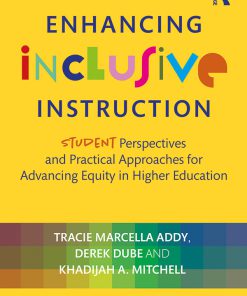Measuring and Enhancing the Student Experience 1st Edition by Mahsood Shah 0081009208 9780081009208
$50.00 Original price was: $50.00.$25.00Current price is: $25.00.
Measuring and Enhancing the Student Experience 1st Edition by Mahsood Shah – Ebook PDF Instant Download/DeliveryISBN: 0081009208, 9780081009208
Full download Measuring and Enhancing the Student Experience 1st Edition after payment.

Product details:
ISBN-10 : 0081009208
ISBN-13 : 9780081009208
Author: Mahsood Shah
Measuring and Enhancing the Student Experience provides insights on how student experiencemeasures could be used to inform improvements at institutional, course, unit of study and teacherlevel. The book is based on a decade of research and practitioner views on ways to enhance thedesign, conduct, analysis, reporting and closing the loop on student feedback data. While the bookis largely based on Australian case studies, it provides learning experiences for other countries wherestudent experience measures are used in national and institutional quality assurance. Consisting of 13chapters, the book includes a wide range of topics including the role and purpose of student feedback,the use of student feedback in staff performance reviews, staff and student engagement, a studentfeedback and experience framework, the first year experience, use of qualitative data, engagingtransnational students in feedback, closing the loop on feedback, student engagement in nationalquality assurance, use of learning analytics and the future of the student experience.
Measuring and Enhancing the Student Experience 1st table of contents:
Chapter 1. Measuring the Student Experience: For Whom and For What Purpose?
1.1. Introduction
1.2. Student Feedback: For Whom and for What Purpose?
1.3. Conclusion
Chapter 2. Student Feedback: The Loophole in Government Policy
2.1. Introduction
2.2. Current Problem
2.3. Strategic Solution
2.4. Conclusion
Chapter 3. Student Feedback: Shifting Focus From Evaluations to Staff Performance Reviews
3.1. Introduction
3.2. Drivers of Change
3.3. Performance-Based Funding and New Accountability
3.4. Political Imperatives or Institutional Improvement?
3.5. Case Study of an Australian University
3.6. Limitations of the Strategy Deployed
3.7. Conclusion and Future Implications
Chapter 4. Why Should I Complete a Survey? Non-responses With Student Surveys
4.1. Introduction
4.2. Does Student Participation Matter?
4.3. Methodology
4.4. Findings
4.5. Some Notable Changes
4.6. Conclusion
Chapter 5. Engaging Students and Staff in Feedback and Optimising Response Rates
5.1. Introduction
5.2. Response Rates
5.3. Incentives
5.4. Survey Fatigue
5.5. Communication
5.6. Acknowledgement
5.7. Ownership
5.8. Acceptable Response Rates
5.9. A Useful Recipe
5.10. Conclusion
Chapter 6. A Student Feedback and Experience Framework
6.1. Introduction
6.2. Need for a Framework
6.3. Current Shortcomings
6.4. A Possible Framework for Surveys and Improvements
6.5. Conclusion
Chapter 7. Measuring the Expectations and Experience of First-Year Students
7.1. Introduction
7.2. Rationale for Surveying First-Year Students
7.3. Methodology
7.4. Overall Findings
7.5. Subgroup Analysis
7.6. Conclusion and Future Implications
Chapter 8. Accessing Student Voice: Using Qualitative Student Feedback
8.1. Introduction
8.2. Methods
8.3. Findings
8.4. Discussion
8.5. Conclusion
Chapter 9. Engaging Transnational Students in Quality Assurance and Enhancement
9.1. Australian Transnational Education
9.2. Monitoring the Transnational Student Experience: Past Practices
9.3. Current Policy Directions
9.4. Transnational Student Experience
9.5. Conclusion
Chapter 10. Closing the Loop: An Essential Part of Student Evaluations
10.1. Introduction
10.2. Closing the Loop
10.3. Are There Negative Implications for Not Closing the Loop?
10.4. Strategies to Implement Closing the Loop
10.5. Conclusion
Chapter 11. Student Engagement in National Quality Assurance
11.1. Introduction
11.2. Student Engagement
11.3. From External Quality Agency to National Regulator
11.4. Prominence of the Student Voice
11.5. Conclusion
Chapter 12. Using Learning Analytics to Assess Student Engagement and Experience
12.1. Introduction
12.2. Learning Analytics
12.3. Learning Analytics and Its Stakeholders
12.4. Learning Analytics Elements, Process, Tools and Resources
12.5. Use of Learning Analytics
12.6. Indicators Used as Part of Learning Analytics
12.7. Discussion
Chapter 13. Measurement and Enhancement of Student Experience: What Next?
13.1. Introduction
13.2. Monitoring the Student Experience to Date
13.3. Where Are We Heading in Monitoring the Student Experience?
13.4. Administration and Type of Surveys
13.5. Use of Data
13.6. Performance Reporting
13.7. Professional Development
13.8. Research
13.9. Concluding Remarks
People also search for Measuring and Enhancing the Student Experience 1st:
measuring student engagement
measuring student engagement in the classroom
measuring student achievement
measuring student success in the classroom
to measure a student’s retention of knowledge
Tags: Measuring, Enhancing, Student Experience, Mahsood Shah
You may also like…
Education Studies & Teaching - History of Education
Religion & Spirituality - Islam
The Book of the Book 1st edition by Idries Shah 1784793469 9781784793463
Education Studies & Teaching - School Education & Teaching
Wellbeing in Doctoral Education Insights and Guidance from the Student Experience Lynette Pretorius
Religion & Spirituality
Uncategorized
Education Studies & Teaching - School Education & Teaching
Fiction - Young Adult
Aru Shah and the Tree of Wishes Pandava 3 1st Edition Roshani Chokshi
Fiction - Fantasy
Aru Shah And The Song Of Death Pandava 2 1st Edition Roshani Chokshi












